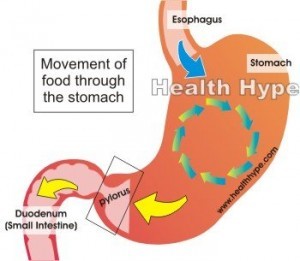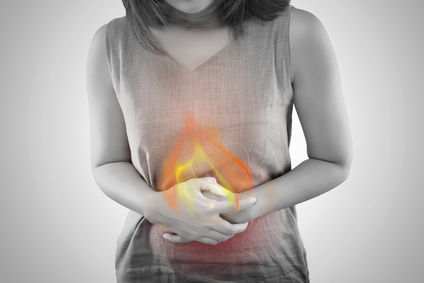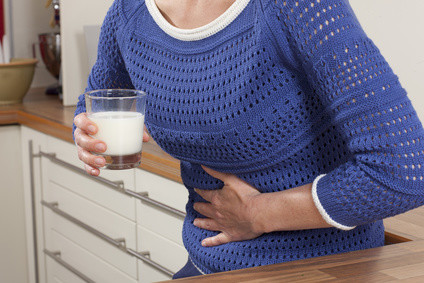Stomach Churning Sensation (Feeling), Causes, Remedies
Most people use everyday terms to describe the symptoms that they are experiencing. While the medical fraternity is accustomed to technical terms for specific conditions, it is often easier to explain a symptom as it feels or appears. One such common term is a churning stomach or bowels. We all have experienced this sensation at some time or the other in life, and often wonder why it is occurring and what may be causing it. The real concern arises when the feeling is intense, persistent and accompanied by other serious signs and symptoms.
What does stomach churning mean?
Stomach churning is a term that often describes excessive contractions of the stomach and bowels (hyperperistalsis) usually with a sick in the stomach feeling (nausea). It can occur for a number of reasons but indicates that the gut is irritated or overactive. It may be similar to an upset stomach, another common term that is used to describe indigestion. Although the stomach is a specific organ, it is often referred to in terms of gastrointestinal and even general abdominal symptoms. So a churning stomach may not be a stomach symptom at all.
What is hyperperistalsis?
Peristalsis is the normal bowel motions that move food and wastes through the different parts of the gut. It also helps with mixing food with digestive enzymes and mechanically breaking it down in the stomach. Smooth muscle in the wall of the gut makes peristalsis possible. These muscles are stimulated to contract or relax by nerves. These nerves are in turn controlled by the brain or by local nerve reflexes.
Peristalsis starts from as high up as the throat and continues all the way to the rectum. It is involuntary. This means it occurs on it own without you being able to control it. The strength, frequency and coordination of the contractions in peristalsis varies depending on a number of factors. Most of the time we barely feel these contractions. However, when it is excessive then it is referred to as hyperperistalsis.

Signs and Symptoms
A churning stomach is a symptom. It may be accompanied by a host of other symptoms, or can occur on its own. Given that the term stomach churning is somewhat vague at times, it may also be loosely used to describe nausea, bloating and intermittent abdominal cramps.
Normal and Abnormal Stomach Sensations
We all know some of the normal sensations from the stomach region that we feel during the course of the day, especially when hungry or after eating. When hungry, we experience hunger pangs, sometimes burning and strong contractions. This is largely normal. When we eat a good meal, we feel a sensation of fullness in the stomach. Sometimes there is a bloated feeling from eating too much and gurgling noises from the stomach. This is also normal to a large degree.
Abnormal stomach sensations can vary in nature and intensity. A very tight or bloated feeling is abnormal. So is a burning sensation, dull ache or pain in the stomach. Perceiving mild contractions when hungry or after a meal may be normal, as is the stomach noises that may be audible. However, excessive and strong contractions with/without abnormally loud noises is not normal. This is largely what a churning stomach is perceived as along with other symptoms discussed below.

Other Symptoms
- Nausea is one of the common symptoms that accompanies stomach churning.
- Vomiting may accompany the nausea in some instances.
- Bloating where there is a sensation of fullness (“stomach bursting”) sensation in the upper abdomen.
- Borborymi (stomach noises) that are abnormally loud and/or prolonged.
- Alterations in bowel habit like diarrhea or constipation.
- Excessive gas experienced as frequent belching or flatulence.
- Abdominal pain or cramping which may be also described as stomach churning in some instances. Also refer to stomach cramps.
- Heartburn, which is a burning chest pain due to reflux (rising stomach acid in the esophagus).
Causes of Churning Stomach
There are a number of possible conditions that may present with stomach churning. Some are more serious than others, especially when profuse vomiting and diarrhea are present. These conditions can be classified as acute or chronic.
Acute Causes (Sudden, Short Term)
Acute conditions usually start up suddenly and persist for a short period of time, until it resolves on its own or with treatment.
- Indigestion (dyspepsia) often associated with overeating, oily/spicy meals, offensive stimuli (unpleasant tastes/odors/images), alcohol and excessive caffeine intake, anxiety.
- Infections of the stomach, small intestine and large intestine – food poisoning, gastroenteritis, cholera.
- OTC and prescription medication, particularly NSAIDs and certain antibiotics.
- Overuse of laxatives.
- Oral poisoning or toxicity from overdose.
- Motion sickness.
- Computer vision syndrome (sometimes).
- Prolonged hunger, strict dieting/fasting.
- Strenuous exercise (sometimes), especially abdominal workouts.
- Pregnancy, particularly in the first trimester where morning sickness is prominent.
- Gallstone attack where the pain is not in the stomach or bowels but adjacent to it.

Chronic Causes (Long Term)
Chronic conditions last for a much longer term, from about 3 months onwards. Some are lifelong. It usually develops gradually, as compared to the sudden onset of acute conditions. However, there may be acute flareups with many chronic conditions where the symptoms are intense and starts up suddenly. These flareups are short lived.
- Irritable bowel syndrome (IBS) where the bowel are usually overactive (diarrhea-predominant type).
- Inflammatory bowel disease (IBD), particularly during acute flareups.
- Lactose intolerance (milk intolerance) where the symptoms start after consuming milk/dairy. Similar symptoms may arise with other food intolerance or malabsorption syndrome.
- Celiac disease where there is an autoimmune reaction to gluten (wheat protein).
- Pancreas and/or gallbladder disease where the breakdown of foods may be impaired.
- Adhesions which are collections of scar tissue that develop in some people after abdominal surgery.
- Premenstrual syndrome (PMS) which occurs monthly and where nausea/vomiting are prominent symptoms.
- Gastrointestinal obstruction, particularly around the stomach outlet or lower down the gut.
Remedies To Ease Stomach Churning
Medical treatment for stomach churning has to be directed at the cause. This has to first be diagnosed by a doctor. However, not every person will seek medical attention for acute stomach churning. Often simple home remedies and over-the-counter (OTC) medication may be first used. These is no specific remedy for stomach churning, however, the following measures may offer momentary relief until medical attention can be sought.
- Increase water intake. Sip slowly on water, either room temperature or cold.
- Stand up straight and walk around slowly to aid digestion.
- Peppermint and ginger teas are purported to assist with digestive symptoms.
- Antacids can be helpful in easing indigestion.
- Effervescent salts may help in relieving gas.
- Avoid any further intake of caffeinated beverages (tea, coffee and cola) or alcoholic drinks.
- Try to pass stool, but do not strain. Sometimes having a bowel movement can help the churning to ease or subside.
Last updated on September 24, 2018.




